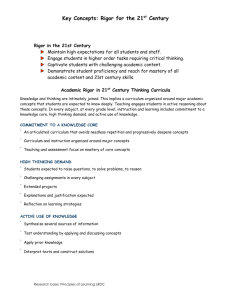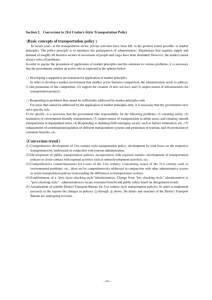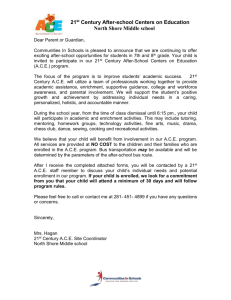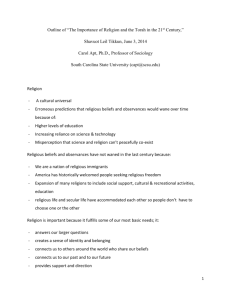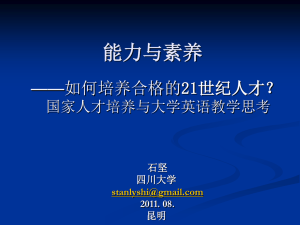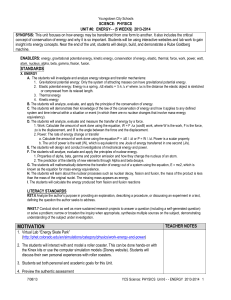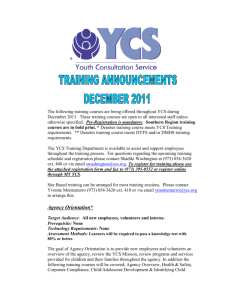Unit 8 - Youngstown City Schools
advertisement
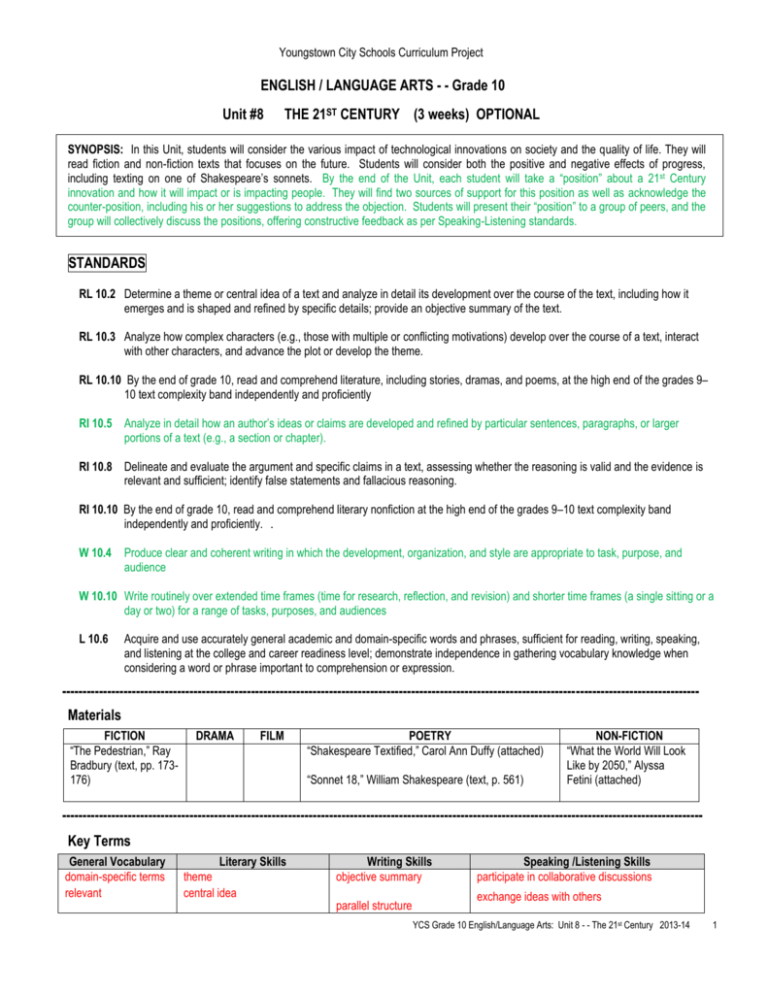
Youngstown City Schools Curriculum Project ENGLISH / LANGUAGE ARTS - - Grade 10 Unit #8 THE 21ST CENTURY (3 weeks) OPTIONAL SYNOPSIS: In this Unit, students will consider the various impact of technological innovations on society and the quality of life. They will read fiction and non-fiction texts that focuses on the future. Students will consider both the positive and negative effects of progress, including texting on one of Shakespeare’s sonnets. By the end of the Unit, each student will take a “position” about a 21st Century innovation and how it will impact or is impacting people. They will find two sources of support for this position as well as acknowledge the counter-position, including his or her suggestions to address the objection. Students will present their “position” to a group of peers, and the group will collectively discuss the positions, offering constructive feedback as per Speaking-Listening standards. STANDARDS RL 10.2 Determine a theme or central idea of a text and analyze in detail its development over the course of the text, including how it emerges and is shaped and refined by specific details; provide an objective summary of the text. RL 10.3 Analyze how complex characters (e.g., those with multiple or conflicting motivations) develop over the course of a text, interact with other characters, and advance the plot or develop the theme. RL 10.10 By the end of grade 10, read and comprehend literature, including stories, dramas, and poems, at the high end of the grades 9– 10 text complexity band independently and proficiently RI 10.5 Analyze in detail how an author’s ideas or claims are developed and refined by particular sentences, paragraphs, or larger portions of a text (e.g., a section or chapter). RI 10.8 Delineate and evaluate the argument and specific claims in a text, assessing whether the reasoning is valid and the evidence is relevant and sufficient; identify false statements and fallacious reasoning. RI 10.10 By the end of grade 10, read and comprehend literary nonfiction at the high end of the grades 9–10 text complexity band independently and proficiently. . W 10.4 Produce clear and coherent writing in which the development, organization, and style are appropriate to task, purpose, and audience W 10.10 Write routinely over extended time frames (time for research, reflection, and revision) and shorter time frames (a single sitting or a day or two) for a range of tasks, purposes, and audiences L 10.6 Acquire and use accurately general academic and domain-specific words and phrases, sufficient for reading, writing, speaking, and listening at the college and career readiness level; demonstrate independence in gathering vocabulary knowledge when considering a word or phrase important to comprehension or expression. ----------------------------------------------------------------------------------------------------------------------------------------------------------Materials FICTION “The Pedestrian,” Ray Bradbury (text, pp. 173176) DRAMA FILM POETRY “Shakespeare Textified,” Carol Ann Duffy (attached) “Sonnet 18,” William Shakespeare (text, p. 561) NON-FICTION “What the World Will Look Like by 2050,” Alyssa Fetini (attached) -----------------------------------------------------------------------------------------------------------------------------------------------------------Key Terms General Vocabulary domain-specific terms relevant Literary Skills theme central idea Writing Skills objective summary parallel structure Speaking /Listening Skills participate in collaborative discussions exchange ideas with others YCS Grade 10 English/Language Arts: Unit 8 - - The 21st Century 2013-14 1 sufficient fallacious reasoning reading vocabulary listening vocabulary speaking vocabulary writing vocabulary how central idea is shaped complex characters (how developed over text) how character advances plot, theme relevant, sufficient evidence delineate and evaluate argument valid vs invalid reasoning summarize parallel structure respect diverse opinions various types of phrases and clauses refer to evidence from other sources conventions of standard English ( semi-colon; colon; spelling) integrate multiple sources of information follow rules for collegial discussion identify a speaker’s point of view, reasoning, and use of evidence adapt speech to a variety of contexts MOTIVATION 1. Teacher discusses the term “21st Century” with students. Prompt for vision, leaning forward, progress, developments in science, industry, technology, medicine, etc. TEACHER NOTES 2. Teacher asks students about 21st Century topics (e.g., chip implants; cloning; external skeletons) in medicine, computing, transportation, communication, climate change, space travel, etc. Teacher lists students’ ideas on Board or chart paper. 3. Students debate “how do these enhance life ? . . . jeopardize it?” Teacher makes two lists on board. 4. Students Journal about a technology they use - - how it functions NOW; how it will function 25 YEARS FROM NOW. 5. Teacher previews the Unit, clarifying performance expectations. NOTE: make sure students know they’ll be preparing and delivering a speech about what they think the world will be like in 2050. NOTE to TEACHER: in planning, allow 4-5 class periods for the final project. Students will compile a “position” using two outside sources; present it to a small group of students (who will compete a SpeakingListening Rubric); and then re-group to hold a discussion about the “positions” presented. 6. Teacher helps students identify personal and academic goals. TEACHING-LEARNING ACTIVITIES TEACHER NOTES Remove SLs Remove L 10.1 and L 10.2 [ “The Pedestrian” by Ray Bradbury ] 1. The teacher provides background about science fiction writing and the author, Ray Bradbury. [ see text, or use Internet cite. ] 2. Teacher asks students what technology has developed since 2000 - - the first 12 years of the 21st century. ( Attachment #1) NOTE TO TEACHER: Time Magazine has videos of the 50 Best Inventions of 20XX - - whatever the year. 3. Students are divided into 2s or 3s to read the story; students read aloud to each other (taking turns). Each team takes notes on 21st Century ideas and unfamiliar words. At the end of the reading, the teams will complete a Processing Guide (Attachment #2) (RL 10.2; RL 10.3) 4. Teacher and students return to Motivation list of how technology “enhances” and “jeopardizes;” YCS Grade 10 English/Language Arts: Unit 8 - - The 21st Century 2013-14 2 reconsiders the list after having read the Bradbury story. Add to the lists ?? [ Poetry ] 5. Teacher discusses with students how writing as a form of communication has changed over time. Teacher asks students to give examples of how technology has played a role in writing over time. ( e.g., hieroglyphics / chisels; scrolls / quills; paper . . . . monks transcribed scriptures . . . printing press; typewriters . . . . the photocopier . . . . fax . . . computers . . . laptops . . . i-pads, etc.). Focus on ho “texting” has impacted the art of communication. 6. Teacher shares “Shakespeare Textified” by Carol Ann Duffy (Attachment #3). Students do what they can to decode it. 7. Teacher asks students to turn to p.561 of text to read the actual “Sonnet 18.” Teacher and students compare the two texts to see how close they came. Students and teacher interpret the actual sonnet. Teacher reminds students of sonnet as an art form (i.e., 14 lines of iambic pentameter; the stress falls on every other syllable - - or sometimes entire word; divided into 3 quatrains - - 4 lines each with rhyme scheme ABAB - - each of which describes an image or idea; the sonnet is tied off with couplet [2 lines] with rhyme scheme of CC that provides a new take on the theme or explains the “why” of it all.) 8. Students Journal “What is lost when a piece is texted?” [ “What the World Will Look Like by 2050,” Alyssa Fetini ] - - Attachment #4 9. Teacher explains that the article “What the World Will Look Like by 2050” is a quick “skim” of an entire book written by Jacques Attali. Students read the article in small groups (3 or 4) and determine what Fetini thinks Attali is saying and whether they feel Mr. Attali’s ideas are valid. Students (a) decide if the evidence presented is relevant and sufficient, justifying their thinking in writing; and (b) identify which of Mr. Attali’s predictions have come true since 2009. The groups then compare their ideas aloud. (RI 10.8) 10. Groups exchange members. They discuss the events that have happened SINCE 2009. What might Mr. Attali add to his ideas since 2009? Each team makes a list. TRADITIONAL ASSESSMENT 1. Unit Test ( consisting of multiple choice and 2- and 4-point essay items ); include RL 10.2; RL 10.3; RI 10.8; L 10.1; and L 10.2 TEACHER NOTES TRADITIONAL ASSESSMENT 2. Journals / Notebook entries TEACHER NOTES [ cont’d ] 3. Each student evaluates his and her personal and academic goals for the Unit. AUTHENTIC ASSESSMENT Each student will - 1. evaluate his and her performance on Unit Goals 2. TEACHER NOTES St nroms for the conversation prepare a “position” on some aspect of 21st Century like (see Motivational list); find 2 different sources to support his or her position. From the notes taken, the student prepares a “speech” to convince peers of their “position” as per the following guidelines. a. b. thesis idea (“position” stating what and why) support from source 1 (and identify the source) YCS Grade 10 English/Language Arts: Unit 8 - - The 21st Century 2013-14 3 c. d. e. f. support from source 2 (and identify the source) how the student’s position would enhance the quality of like in America or the world why critics or opponents would object to the position, and how those objections would be addressed if the student’s position were accepted one visual aid or graphic to clarify (L 10.1; L 10.2; SL 10.2) 3. present the “position” to a group of peers, who will process what they hear using a Speaking / Listening Rubric (Attachment #5). (SL 10.3; SL 10.6; L 10.1; L 10.2; L 10.3; L 10.6) 4. participate in the group’s reflection on each of the speeches presented; the groups will a. set norms for the discussion, including roles and responsibilities (SL 10.1 b) b. refer to notes taken on Speaking/Listening Rubric to make comments about students’ “positions” (SL 10.1 a) c. evaluate other students’ “positions” as per Rubric criteria and other norms discussed during the Unit (SL 10.3) NOTE: will not require separate forms for the Authentic Assessment YCS Grade 10 English/Language Arts: Unit 8 - - The 21st Century 2013-14 4 Attachment #1 Technology Advances Between 2000 and 2013 2000: Hybrid Car — Toyota released the Toyota Prius, the first hybrid four-door sedan available in the United States. Hybrid cars use a gasoline or diesel engine to power a motor. When the power of the motor is not required to move the vehicle, the motor can shut off, saving energy, or can be used to generate electricity that is stored in batteries, and later used to power the car. Between 2004 and 2009 it is estimated that 1.25 million of these vehicles were sold in the United States. To this day the Prius is still the most popular vehicle of its kind. 2001: Segway PT — Created by Dean Kamen the Segway Human Transporter is the first self-balancing, electric-powered transportation machine. It is a personal transport device that uses five gyroscopes and a built-in computer to remain upright. iPod, 1st generation - - On October 23, 2001 Apple Computers publicly announced their portable music digital player, the iPod, created under project codename Dulcimer. One man that could be named the father of the iPod is Tony Fadell. Tony, a former employee of General Magic and Phillips, wanted to invent a better MP3 player. He went to work for Apple Computers in 2001 as an independent contractor, leading a team of thirty people to develop the new MP3 player. Within eight months, Tony Fadell’s team and PortalPlayer completed a prototype iPod and Apple polished the user interface adding the famous scroll wheel. Apple announced in April 2007 that the 100 millionth iPod had been sold. Apple claims the iPod is the fastest-selling music player in history. It is estimated that approximately 86% of MP3 player users own an iPod, an astounding figure. 2002: Camera Phones — Introduced to the North American marketplace in 2002, an estimated 80 million camera phones were sold in 2003, — 6 million in the U.S. alone. By 2003 more camera phones were sold worldwide than stand-alone digital cameras. At the end of 2008, the world- - Installed base of camera phones was 1.9 billion. 2003: Itunes Music Store — the concept was simple: sell songs in digital format for less than a buck and let buyers play them whenever and wherever they like—as long as it was on an Apple iPod. Steve Jobs, Apple’s CEO spent the previous year negotiating an unprecedented deal with all five major music labels and thousands of independents. His iTunes software, would become a gateway to the Music Store, where you could easily find and save music to your hard drive, CD or iPod music player—no subscription necessary, just 99 cents per song, or $9.99 for an album. As of January 2009, the store has sold 6 billion songs, accounting for 70% of worldwide online digital music sales and making the service the largest legal music retailer. 2004: DirecTV HD DVR — Rated by CNET as one of the top ten products at the CES 2004 show, this TIVO device took digital video recording to the next level. The 250GB drive held 30 hours of high-def programming or 200 hours of standard TV. I bought one of these puppies when they first arrived in the marketplace and it was one of the best a/v component purchases I have ever made. Blogs YCS Grade 10 English/Language Arts: Unit 8 - - The 21st Century 2013-14 5 Attachment #1, p. 2 2005: YouTube — Created in February 2005, by three former PayPal employees, YouTube was touted as a cutting-edge video sharing service. In November 2006, YouTube, LLC was bought by Google Inc. for $1.65 billion, and is now operated as a subsidiary of Google. Alexa ranks YouTube as the fourth most visited website on the Internet, behind Google, Yahoo! and Facebook. 2006: Wii — is a home video game console released by Nintendo. A distinguishing feature of the console is its wireless controller, the Wii Remote, which can be used as a handheld pointing device and detects movement in three dimensions. Another distinctive feature of the console is WiiConnect24, which enables it to receive messages and updates over the Internet while in standby mode. As of December 2009, the Wii leads the generation over the PlayStation 3 and Xbox 360 in worldwide sales. 2007: The iPhone – who else, but of course Steve Jobs, CEO for Apple, Inc. to take smartphones to a higher standard. This device, though controversial, is pretty, touchy-feely, and has a tremendous future. Approximately 6.4 million iPhones are active in the U.S. alone. 33.75 milliion of the devices have been sold world-wide to date. (Both 1st and 2nd generation) 2008: Amazon Kindle — With the paper-like legibility of electronic ink, long battery life, and the ability to hold thousands of pages, e-book readers were already quite handy in 2008. But Amazon made them even more convenient by adding a free cellular connection for plucking newspapers, magazines—even entire books—out of the air in seconds. A truly brilliant innovation! 2009 - 2013: Jump-Drives Wii and Play Station Twitter Face Book The Tablets Cloud computing Genetically-modified organisms The Android [ Smart ] Phone YCS Grade 10 English/Language Arts: Unit 8 - - The 21st Century 2013-14 6 Attachment #2 Processing Guide for “The Pedestrian” by Ray Bradbury Unfamiliar Terms and Phrases - - particularly connected to futuristic ideas Page/Column Word or Phrase Predicted Definition from Context Theme / Central Idea: (RL 10.2) _____________________________________________________________________________________ How it is developed over the text: _____________________________________________________________________________________ _____________________________________________________________________________________ _____________________________________________________________________________________ Complex Characters - - how they interact with other characters to advance the plot (RL 10.3) Character Interactions With Other Characters How This Character Advances the Plot YCS Grade 10 English/Language Arts: Unit 8 - - The 21st Century 2013-14 7 YCS Grade 10 English/Language Arts: Unit 8 - - The 21st Century 2013-14 8 Attachment #2, p. 2 Prepare an Objective Summary of the Story (RL 10.2) _____________________________________________________________________________________ _____________________________________________________________________________________ _____________________________________________________________________________________ _____________________________________________________________________________________ _____________________________________________________________________________________ _____________________________________________________________________________________ YCS Grade 10 English/Language Arts: Unit 8 - - The 21st Century 2013-14 9 Attachment #3 BARD ENGLISH: SHAKESPEARE TEXTIFIED 'Shll I cmpre thee 2 a smmrs dy Tho art mre lvly + mre tmprte Rgh wnds do shke da drlin bds of may + smmrs lese hath all 2 shrt a dte smtmes 2 hot da i of hvn shnes + oftn s hs gld cmplxn dimmd + evry fair frm fair smtms dilclns by chce r ntre's chngig corse untrmmd Bt thy eternl smmr shll nt fde nr lse pssessn of dat fair tho owst Nr sll Dth brg tho wndr'st n his shde whenin etrnl lnes 2 time tho grwst so lng as mn cn brthe or i's cn c so lng lvs dis + dis gvs lfe 2 thee' YCS Grade 10 English/Language Arts: Unit 8 - - The 21st Century 2013-14 10 Attachment #4 The Skimmer What the World Will Look Like by 2050 By Alyssa Fetini Monday, Time Magazine; Apr. 13, 2009 A Brief History of the Future: A Brave and Controversial Look at the Twenty-First Century By Jacques Attali; Arcade Publishing; 312 pages The Gist: Imagine a world where pirates run amok, blowing themselves up in European city centers; where wars are ignited over lack of drinking water; where a global face-off between Islam and Christianity makes World War II look like a water-balloon fight. According to economist and political scientist Jacques Attali, that is what the future has in store for us by 2025. In the belief that past experiences are indicative future events, Attali combs through the history of human kind, all the way back to Homo Habilis, separating the past into nine distinct periods to isolate "what is possible, what changes and what is unvarying" and applies those trends to the coming century. Attali's predictions range from the future of journalism (completely paperless) to the end of the economic crisis (around 2011), offering a glimpse into the future that is both provocative and petrifying. (See 10 ideas that are changing the world right now.) Highlight Reel: On the future of the American empire: "After a very long struggle and in the midst of a serious ecological crisis, the still dominant empire- the United States- will finally be defeated around 2035 by the same globalization of the markets (particularly the financial ones), and by the power of corporations. Financially and politically exhausted, like all other empires before it, the United States will cease to run the world. But it will remain the planet's major power; no new empire or dominant nation will replace it. The world will temporarily become polycentric with a dozen or so regional powers managing its affairs." On the future of the climate: "With the marked increase in temperature changes, very important alterations will take place in nature. Trees will grow faster and will become more fragile... Much more serious: many more coastlines could become uninhabitable. Seven of the worlds biggest cities are ports, and a third of the world's population lives on a coastline... Ecoexiles will become ten times more numerous by 2050." On the future of weapons of mass destruction: "Now pointed at Japan, North Korea's missiles will one day target the United States and China. The missiles of Pakistan fallen into the hands of fundamentalists will threaten first India, then Europe. Those of Hezbollah — in other words, Iran — that now target Israel will one day be pointed at Cairo, Riyadh, Algiers, Tunis, Casablanca, Istanbul, then at Rome, Madrid, London and Paris. Should the battle lines harden YCS Grade 10 English/Language Arts: Unit 8 - - The 21st Century 2013-14 11 and the country be threatened with annihilation, China's missiles could one day target Japan and the United States." Attachment #4, p. 2 On the future of cloning: "After repairing diseased organs, they will want to produce them, then create replacement bodies. First they will produce lineages of stem cells without destroying the embryo, which will make genetic therapy ethically acceptable, and then reproductive cloning. Finally they will manufacture the human being like a made-to-measure artifact, in an artificial uterus, which will allow the brain to further develop with characteristics chosen in advance. The human being will thus have become a commercial object." The Lowdown: As the cofounder and first president of the European Bank for Reconstruction and Development, Attali won fame for calling the U.S. financial collapse as early as 2006 — giving him more credibility than the average soothsayer. However, many of his predictions range from the absurd to the, well... predictable. His belief that Israel must keep its status as a regional power in order to survive is not exactly rocket science, while his belief that a utopia of altruistic "transhumans" will emerge from the ashes of mid-21st century planetary warfare is a bit hard to swallow. His more outrageous predictions notwithstanding, Attali correctly notes that our future is not inevitable. Mankind must learn how to appropriately respond to the crises and opportunities that await us, and grow cognizant of the fact that large-scale violence can be so dangerous to humanity so that we become "aware of the need for a radical change in attitude." Whether his predictions are worth taking seriously or not, they all inevitably turn on the endless capacity of human resilience — a notion that appears to be the only true constant for the future, and the most reassuring. Read more: http://www.time.com/time/arts/article/0,8599,1890927,00.html#ixzz2T4knQQnm YCS Grade 10 English/Language Arts: Unit 8 - - The 21st Century 2013-14 12 Attachment #5 SPEAKING-LISTENING RUBRIC In the empty squares, please indicate a 3 = strong, a 2 = fair, a 1 = weak, or 0 = not there Presenter ___________________________ Topic ______________________ Date _________ Observer/Listener _______________________________ Class Period ____________________ PRESENTATION Content 1. Thesis idea what and why 2. Support source 1 _________________________________________ convincing? or not ? _______________________________ source 2 _________________________________________ convincing? or not ? _______________________________ 3. How the position would enhance the quality of life ____________________________________________________________ ____________________________________________________________ 4. Objections from critics ____________________________________________________________ ____________________________________________________________ GRAPHIC relevant attractive easily understood Comment _______________________________________________________________ MANNERISMS eye contact body language clarity of speaking appropriate language Comment _______________________________________________________________ YCS Grade 10 English/Language Arts: Unit 8 - - The 21st Century 2013-14 13 Attachment #5, p. 2 DISCUSSION 1. observes group “norms” as established Comment __________________________________________________________ 2. student refers to notes taken (Rubric) during presentations to make comments Comment __________________________________________________________ 3. evaluates peers’ “positions” constructively, including affirmations Comment __________________________________________________________ YCS Grade 10 English/Language Arts: Unit 8 - - The 21st Century 2013-14 14


